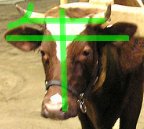Ten thousand, Myriad
Consists of the kanji for "one" (一) and an extended version of the "wrapping enclosure" radical (勹). Chinese numbering system groups numbers every 4 digits (myriad) instead of every 3 digits (thousand) which is commonly used in western countries. This kanji describes the number (multiplication) at which the digits will be grouped (wrapped) into one new unit (which is every ten thousand / myriad).
- 一万 (いちまん) Ten thousand
- 百万 (ひゃくまん) One million
方 (ホウ、かた)
Direction, Person (honorific)
 |
| By pyriet (Flickr) CC BY-NC-SA 2.0 |
Consists of the "lid" radical and the extended version of the "wrapping enclosure" radical. Together they describe an enclosure made of lids (blockage). A lid's function is basically to provide a blockage so that the content of a container (jar, kettle, etc) doesn't spill out. An "enclosure of lids" provides necessary blockages so that something goes through a certain direction. For example, a lamp housing/reflector consists of blockages ("lids") at the sides and the back, whose function is to direct the light forward. Another example, a chimney consists of blockages at the sides, whose function is to direct the smoke up & out of the house. The usage of this kanji to mean "person" in honorific language is in line with the fact that directions are also used as personal pronouns (e.g "kochira koso").
- 方々 (かたがた) They (of people, honorific)
- 夕方 (ゆうがた) Evening, Dusk
- 見方 (みかた) Viewpoint
- 生き方 (いきかた) Way of life
牛 (キュウ、うし)
Cow, Ox
 |
| By normanack (Flickr) CC BY 2.0 |
This kanji describe the layout of a cow's head. The diagonal stroke and the upper horizontal stroke represent the horns which have the tendency to curve upward. The lower horizontal stroke represent the ears, and the vertical stroke represent the length from the forehead to the mouth. Notice that the top of the vertical line goes through the upper horizontal line. It represents the protuberance of the skull between the horns, which is called intercornual protuberance.
父 (フ、ちち)
Father
 This kanji is a picture of a man embracing something with crossed hands, giving protection. The upper 2 strokes represent the common posture of a man, which has wide shoulders. The lower strokes represents the crossed hands. A father is a man whose role is to give us protection.
This kanji is a picture of a man embracing something with crossed hands, giving protection. The upper 2 strokes represent the common posture of a man, which has wide shoulders. The lower strokes represents the crossed hands. A father is a man whose role is to give us protection.- お父さん (おとうさん) Father (honorific)
母 (ボ、はは、も)
This kanji is a squared and rotated version of a picture of a woman's breasts. The two dots represent the nipples. A mother is a woman who breast-fed us when we were baby.
- お母さん (おかあさん) Mother
- 父母 (ふぼ) Father and mother, Parents
- 母国 (ぼこく) One's homeland
- 母校 (ぼこう) Alma mater
- 母語 (ぼご) Mother tongue, Native language


No comments:
Post a Comment